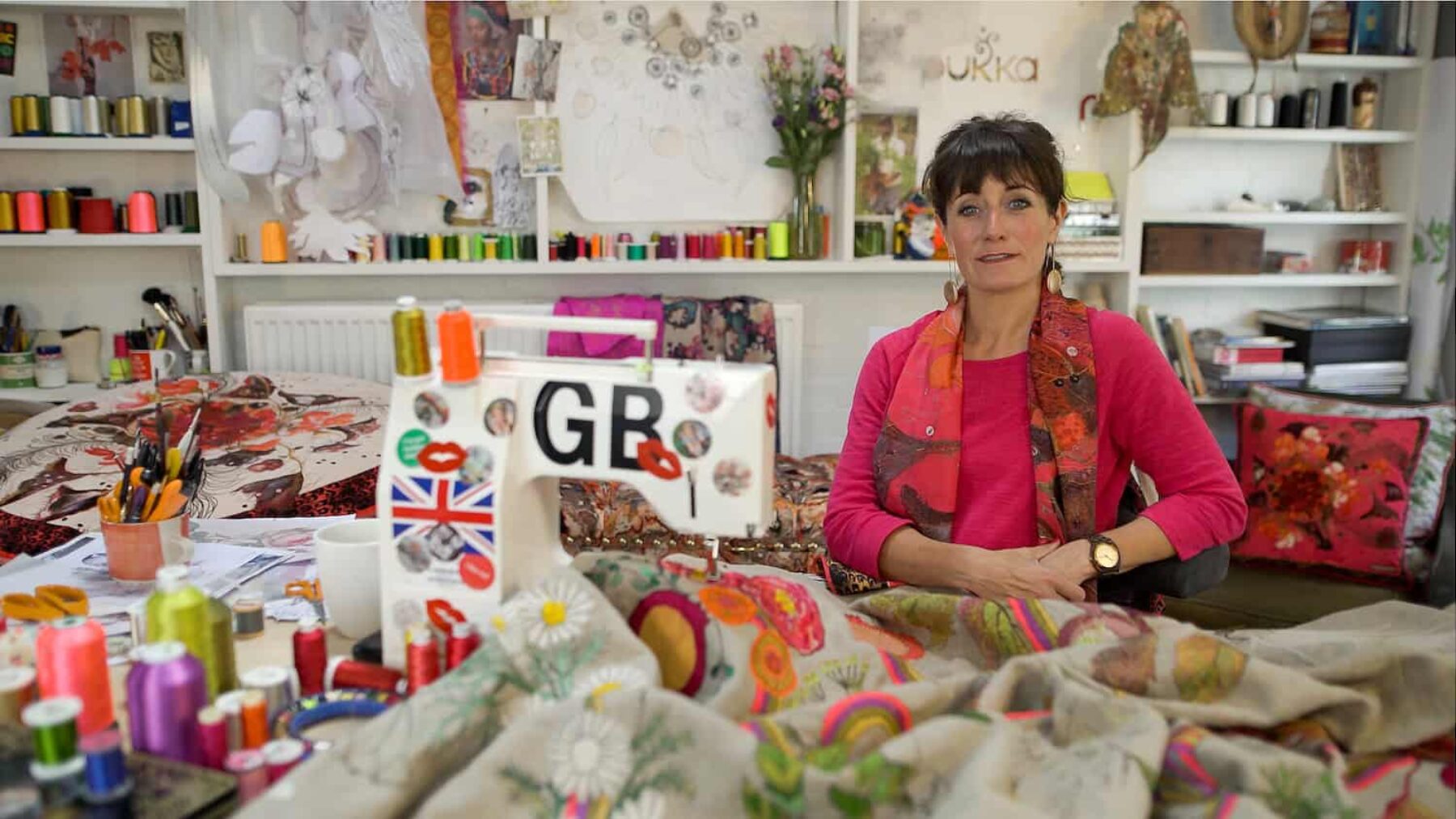Embroidery artist Lou Gardiner has created a unique, wearable piece of art to transform every woman who puts it on into a ‘Wonder Woman’. A cape with an ornate design inspired by herbs that have traditionally been used to support female health, it celebrates the power and beauty of women
It all started with a pint of cider in a West Country pub. Sharing a drink were Lou Gardiner, an artist specialising in vast, shimmering works of embroidery, and Fox, marketing director of Pukka Herbs. Arranged by a mutual friend, it was one of those nice meetings with no agenda, no expectations. But what came out of it was extraordinary – as, indeed, is much of Gardiner’s work.
She springs from a farming family, and her art is almost as old as farming itself: the art of stitching; of drawing together material into something that can be both practical and gorgeous. In her time, she’s made everything from exquisite works hung on the walls of the Saatchi gallery, through public art for children’s hospitals, to vast quilts displayed in the windows of Liberty of London.
Gardiner bubbles with enthusiasm for her craft. “Stitching is such an underrated medium,” she insists, as I interview her over the phone. In part, perhaps, that reflects its history as ‘women’s work’: “the kind of thing women would do sat at home, while their men were off out somewhere being important.”

But its results also carry a particular appeal to women, she believes. “We are somehow drawn to textiles, to fabrics, blankets, silk scarves – things that can wrap, adorn, which can celebrate, nurture.”
Gardiner’s enthusiasm for the link between the embroiderer’s art and the nurturing of women sparked something in Fox, too. Pukka Herbs was building up to a campaign celebrating women and highlighting its range of teas and supplements that combine ingredients known for their ability to support female health. These include aloe vera, ginger, green tea, and the ayurvedic remedies reishi and shatavari (which has the glorious Indian nickname of ‘She who has one hundred husbands’ – the idea being that the herb helps women outlive their men). By the end of that pint of cider, Fox had asked Gardiner “to collaborate with us on an artwork celebrating women”.
“And I thought – great!”, Gardiner recalls. But her next thought was: “So what on earth should I do?” Her first idea was something figurative – a representation of universal ‘woman’. “So I was looking at images of Indian goddesses, of Joan of Arc, of icons, all sorts. But it’s hard to pick just one figure to convey all women. I got stuck thinking, ‘what hair should she have?’. And then it came to me: rather than an artwork picturing a woman, how about something that made every woman into a work of art?”
Stitching the power of womankind
It was a nice idea, but what would that mean in practice? Wrestling with this conundrum, Gardiner took herself off to the cinema. And there, swooping and racing across the screen was her unlikely but perfect answer: Wonder Woman. Or more specifically, her cape.
“It was hilarious! I was sitting there, punching the air, wanting to be her, remembering how as a kid I wanted to be a superhero – and I thought: I’ve got to do a cape!” And not just any old cape, but one which, by enveloping the wearer, could transform her into the artwork celebrating the power and beauty of womankind; turning every woman who wore it into her own Wonder Woman: a cape of empowerment, no less.

That was one problem solved, but what would it look like? Another visit beckoned; this time to the garden run by Pukka’s co-founder and master herbsmith, Sebastian Pole (pictured above with Gardiner). It brims with the plants Pukka put in their teas: ancient healing herbs whose virtue has been proven over centuries – millennia even – of tried and tested practice.
As Pole himself puts it: “The history of human medicine is the history of herbalism. It’s what we’ve always used.” It’s only in the past two generations or so, he says, when we’ve come to depend almost exclusively on the drugs of Western medicine, that “we’ve forgotten what we always relied on”.
The history of human medicine is the history of herbalism. It’s what we’ve always used
As they strolled among the plants, with Pole talking of their various properties – the fennel which helps the flow of breast milk, the marigold to tone the skin, the camomile to soothe a pregnancy – so Gardiner’s vision of her cape became clear: it would showcase the herbs which give strength and healing to women. And it couldn’t be a light, slight, flimsy thing, either.
“I’d never made a wearable work of art before”, she recalls, “so it was a big adventure for me. But I knew from the start that the cape had to feel really substantial. I wanted it to be quite heavy, so that it grounds the wearer to the earth, and almost envelops them with that great herbal wall of protection.”

She retreated to her studio and slowly the cape took shape, spreading across the work surfaces. Woven into it were representations of the herbs from Pukka’s Womankind tea and supplements – 21 in total, from beetroot and camomile to shatavari and marigold – bright and colourful, unfurling, almost exploding, across the fabric.
Gardiner admits to feeling thrilled with the result. “It’s a celebration of the power, the wisdom, the creativity of women: it’s a cape of adventure!” Once it was finished, she wanted as many people as possible to gather that adventure around them. “It’s all very well me making it, but to bring it to life, it has to be worn: it has to adorn as many shoulders as possible.”
I wanted it to be quite heavy, so that it grounds the wearer to the earth
And so, in the last few months alone, the cape’s been everywhere from the Bath Film Festival to Berlin Fashion Week, to Sweden; it’s been laid on the shoulders of women in a hospice and of groups of adults with learning disabilities; it’s gone to Women’s Institutes and, Gardiner adds, “been worn with great pride by a 95-year-old lady in my village”.
As the cape travels from woman to woman – alighting on men’s shoulders too, from time to time – so it “gathers energy”, as Gardiner puts it; taking on, in a way, the stories of those who have worn it. “And when you wear it”, she says, “you step for a moment into a ritual – you become a superwoman – and you become the individual that you really are.”
All images: Pukka Herbs


